By John Treadwell Dunbar ——Bio and Archives--May 1, 2012
Travel | CFP Comments | Reader Friendly | Subscribe | Email Us
 Standing alone for more than 200 years in the harsh desert of southern Arizona above the Santa Cruz River on the Tohono O’odham Reservation ten miles south of Tucson, the Mission San Xavier del Bac is considered to be the finest example of Spanish Colonial architecture in the United States, and the oldest extant European structure in the state of Arizona.
Once rotting under the burdens of time and the elements - scorching heat, torrential monsoon rains, and well-intentioned, though misguided, encasement in an exterior cement veneer during years past - significant restoration efforts are returning the White Dove of the Desert to its original ecclesiastical glory, resurrected, as it were, with love, sweat, and much-needed financial contributions from private, and ever-dwindling public, resources.
Standing alone for more than 200 years in the harsh desert of southern Arizona above the Santa Cruz River on the Tohono O’odham Reservation ten miles south of Tucson, the Mission San Xavier del Bac is considered to be the finest example of Spanish Colonial architecture in the United States, and the oldest extant European structure in the state of Arizona.
Once rotting under the burdens of time and the elements - scorching heat, torrential monsoon rains, and well-intentioned, though misguided, encasement in an exterior cement veneer during years past - significant restoration efforts are returning the White Dove of the Desert to its original ecclesiastical glory, resurrected, as it were, with love, sweat, and much-needed financial contributions from private, and ever-dwindling public, resources. By 1797, after fifteen challenging years, the mission was officially opened for business, religiously speaking. Like then, San Xavier's primary function today is to minister to the O'odham, a nation 24,000 strong living on 2.7 million acres, many of whom are Catholic.
By 1797, after fifteen challenging years, the mission was officially opened for business, religiously speaking. Like then, San Xavier's primary function today is to minister to the O'odham, a nation 24,000 strong living on 2.7 million acres, many of whom are Catholic.
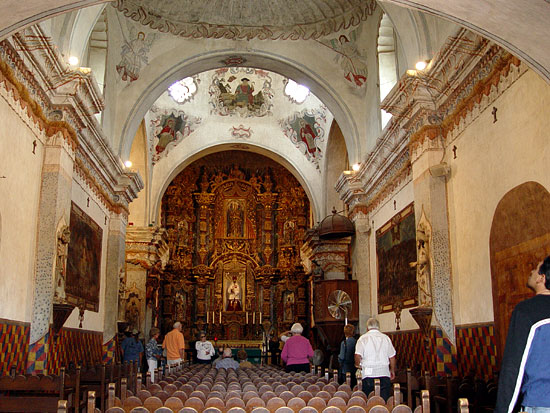 For the spiritual joy of it, and to raise restoration funds, the Patronato San Xavier organizes a series of six Christmas concerts over three nights at the church during mid-December. Now in its fifteenth year, rich harmonies of classical music and Christmas tunes performed by the Sons of Orpheus and the Tucson Arizona Boys Chorus can be heard wafting from the sacred halls of the mission, a sold-out affair which the Arizona Daily Star claims is "beyond dazzling - San Xavier music [and] sights are spectacular." Tickets are $90 per person, $70 of which is tax deductible.
For the spiritual joy of it, and to raise restoration funds, the Patronato San Xavier organizes a series of six Christmas concerts over three nights at the church during mid-December. Now in its fifteenth year, rich harmonies of classical music and Christmas tunes performed by the Sons of Orpheus and the Tucson Arizona Boys Chorus can be heard wafting from the sacred halls of the mission, a sold-out affair which the Arizona Daily Star claims is "beyond dazzling - San Xavier music [and] sights are spectacular." Tickets are $90 per person, $70 of which is tax deductible.
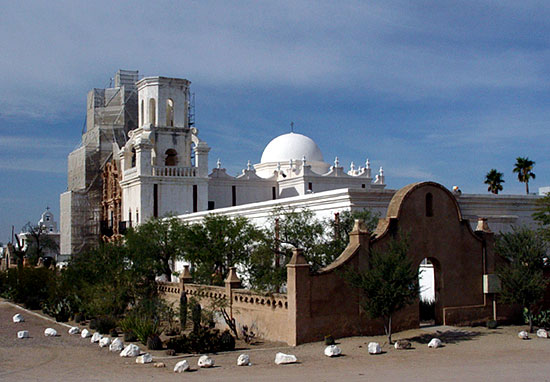 On April 15, 2012, the Clark-Schuldmann Duo also performed here, the fourth annual spring concert popular among chamber music enthusiasts, and likewise aimed at raising restoration funds. Not your typical musicians, the husband and wife cellist-and-pianist team have been described by the New York Times as “an exuberant pair, exhibiting artistic rapport and expressive unity with a quality of ardent commitment that shines through their work.” They have recorded and premiered five dozen works by this country's most noteworthy composers. These tickets will set you back only $75, $65 of which is tax deductible for restoration purposes.
On April 15, 2012, the Clark-Schuldmann Duo also performed here, the fourth annual spring concert popular among chamber music enthusiasts, and likewise aimed at raising restoration funds. Not your typical musicians, the husband and wife cellist-and-pianist team have been described by the New York Times as “an exuberant pair, exhibiting artistic rapport and expressive unity with a quality of ardent commitment that shines through their work.” They have recorded and premiered five dozen works by this country's most noteworthy composers. These tickets will set you back only $75, $65 of which is tax deductible for restoration purposes.
 Because the mission's history is rich and varied, and the interior and exterior visually stunning, it's no wonder that San Xavier has been designated a National Historic Landmark. For those who can't make it to Arizona and experience this marvel first-hand, you can do the next best thing by purchasing “A Gift of Angels: The Art of Mission San Xavier del Bac” by Patronato founder Bernard “Bunny” Fontana and master-photographer Edward McCain. With 175 photographs, and brimming with figures and historical facts, this award-winning book for the ages has been called "gorgeous" by the Review of Arts, Literature, Philosophy and the Humanities, and "stunning" by Midwest Book Review." Published by UA Press in October, 2010, every public library in America and Canada should have a copy of "A Gift of Angels" on its shelf.
As for the historical record: Mission San Xavier initially fell under New Spain's jurisdiction, and later became part of the Republic of Mexico in 1821. San Xavier's last 19th-century resident missionary left the mission in 1837. By 1843 Franciscan administration of all regional missions ended (the Franciscans returned in 1913), after which Mexican priests, the secular clergy, rode the circuit, visiting the mission once a year, if that. Eventually San Xavier was made part of the United States pursuant to the Treaty of La Mesilla, or as Americans call it, the Gadsden Purchase of 1854. Stay with me; its only history.
Because the mission's history is rich and varied, and the interior and exterior visually stunning, it's no wonder that San Xavier has been designated a National Historic Landmark. For those who can't make it to Arizona and experience this marvel first-hand, you can do the next best thing by purchasing “A Gift of Angels: The Art of Mission San Xavier del Bac” by Patronato founder Bernard “Bunny” Fontana and master-photographer Edward McCain. With 175 photographs, and brimming with figures and historical facts, this award-winning book for the ages has been called "gorgeous" by the Review of Arts, Literature, Philosophy and the Humanities, and "stunning" by Midwest Book Review." Published by UA Press in October, 2010, every public library in America and Canada should have a copy of "A Gift of Angels" on its shelf.
As for the historical record: Mission San Xavier initially fell under New Spain's jurisdiction, and later became part of the Republic of Mexico in 1821. San Xavier's last 19th-century resident missionary left the mission in 1837. By 1843 Franciscan administration of all regional missions ended (the Franciscans returned in 1913), after which Mexican priests, the secular clergy, rode the circuit, visiting the mission once a year, if that. Eventually San Xavier was made part of the United States pursuant to the Treaty of La Mesilla, or as Americans call it, the Gadsden Purchase of 1854. Stay with me; its only history.
 San Xavier became part of the Santa Fe Diocese in 1859, and by 1866 the incipient diocese at Tucson (vicariate apostolic) and the vicar apostolic, sent clergy on a regular basis to preside over, and minister to, the flock. A civic-minded patronage, the Patronato San Xavier was created in 1978 by numerous community leaders to promote the conservation of Mission San Xavier. And today, dedicated nuns from the Franciscan Sisters of Christian Charity out of Manitowoc, Wisconsin, operate the mission school.
San Xavier became part of the Santa Fe Diocese in 1859, and by 1866 the incipient diocese at Tucson (vicariate apostolic) and the vicar apostolic, sent clergy on a regular basis to preside over, and minister to, the flock. A civic-minded patronage, the Patronato San Xavier was created in 1978 by numerous community leaders to promote the conservation of Mission San Xavier. And today, dedicated nuns from the Franciscan Sisters of Christian Charity out of Manitowoc, Wisconsin, operate the mission school.
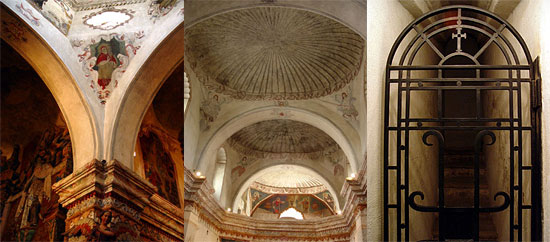 Given the beauty of San Xavier, the tradition and intricate artistic detail, the faux doors and marbling, the multiple adorned domes and sprawling courtyard, and arched doorways, and paintings and deep, rich interior colors, and lofty bell towers, and blinding-white exterior walls, and 200-year-old cracked doors and the Catholic ambiance of the White Dove of the Desert, it's understandable why people from outside the reservation want to get married here, or baptize their children at this church, notwithstanding the corpse resting under glass off in the corner. Not sure why they do that, but it certainly gave me the willies. Though some requests can be accommodated, most can't. The mission reasons that while "[e]veryone is welcome to attend masses, special celebrations (like feast days), etc., ... it is our belief that one's sacramental life should be shared within their local community." This is perfectly reasonable.
Given the beauty of San Xavier, the tradition and intricate artistic detail, the faux doors and marbling, the multiple adorned domes and sprawling courtyard, and arched doorways, and paintings and deep, rich interior colors, and lofty bell towers, and blinding-white exterior walls, and 200-year-old cracked doors and the Catholic ambiance of the White Dove of the Desert, it's understandable why people from outside the reservation want to get married here, or baptize their children at this church, notwithstanding the corpse resting under glass off in the corner. Not sure why they do that, but it certainly gave me the willies. Though some requests can be accommodated, most can't. The mission reasons that while "[e]veryone is welcome to attend masses, special celebrations (like feast days), etc., ... it is our belief that one's sacramental life should be shared within their local community." This is perfectly reasonable.
 Sometimes lost in the rich melody of chamber music, the clatter of restoration activities, pretty postcards and star-struck tourists meandering the narrow halls of the mission are the Tohono O’odham themselves, a people divided by the modern world. The mission was established 300 years ago to service their needs, and continues to do so. Many, but not all, of the O'odham are Catholic, and their lives, like that of many Native Americans have been fraught with difficulty to this day. It's the same sad story with a post-9/11 twist.
Sometimes lost in the rich melody of chamber music, the clatter of restoration activities, pretty postcards and star-struck tourists meandering the narrow halls of the mission are the Tohono O’odham themselves, a people divided by the modern world. The mission was established 300 years ago to service their needs, and continues to do so. Many, but not all, of the O'odham are Catholic, and their lives, like that of many Native Americans have been fraught with difficulty to this day. It's the same sad story with a post-9/11 twist.
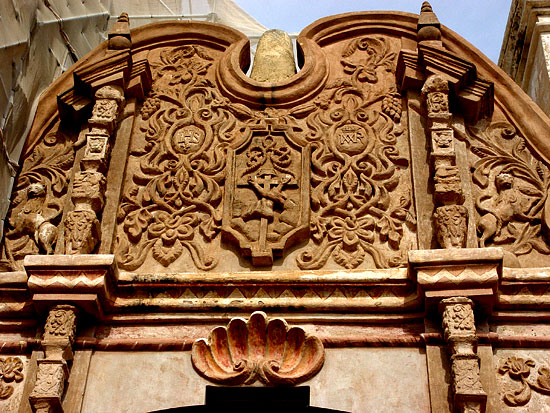 Before the Europeans arrived the O'odham claimed as their traditional homeland the Papagueria, a vast, Southwestern land mass that stretched east from the Gulf of Mexico to the San Pedro River, and north from Sonora, Mexico, to Central Arizona. The Gadsden Purchase of 1854 chopped that in half with establishment of the US/Mexico border. Mexico rounded up their O'odham and forced them onto reservations. Under pressure from settlers, mining interests and the railroads, the O'odham's traditional lands in America shrank appreciably. Still one people, the O'odham could traverse the border relatively unhindered for many generations, and for a long time many didn't even know a border existed.
Before the Europeans arrived the O'odham claimed as their traditional homeland the Papagueria, a vast, Southwestern land mass that stretched east from the Gulf of Mexico to the San Pedro River, and north from Sonora, Mexico, to Central Arizona. The Gadsden Purchase of 1854 chopped that in half with establishment of the US/Mexico border. Mexico rounded up their O'odham and forced them onto reservations. Under pressure from settlers, mining interests and the railroads, the O'odham's traditional lands in America shrank appreciably. Still one people, the O'odham could traverse the border relatively unhindered for many generations, and for a long time many didn't even know a border existed.
 But that changed when the Twin Towers came crashing down (a point evidently lost on the drug cartels, human coyotes, and the undocumented). Legal cross-border movement, the O'odham claim, is greatly restricted under tighter immigration laws, which is understandable given the current geopolitical climate. The old days are a thing of the past for the O'odham. No more can they wander freely across their old hunting grounds, collecting food and materials essential to their religion, economy and culture. No more can they visit sacred sites and family members at will without checking in with the man. It has been reported that overzealous border officials routinely confiscate pine leaves, sweet grass and common bird feathers used in their religion and culture, which if true is downright silly. And like the rest of us, the O'odham must now present border identification cards and passports when entering the USA.
The White Dove of the Desert has had a difficult life, but she's a tough old bird, surviving nature's wrath with dignity like that large earthquake in 1887, and a lightning strike on the West Tower in 1939. But some of the most pernicious damage, from which it continues to reel, was man-caused. Years ago the building's exterior was coated in cement plaster, a big mistake, because it prevented the original material from breathing, trapping moisture beneath which contributed to architectural degradation and decay to the historic brick and adobe infrastructure, and interior art work.
But that changed when the Twin Towers came crashing down (a point evidently lost on the drug cartels, human coyotes, and the undocumented). Legal cross-border movement, the O'odham claim, is greatly restricted under tighter immigration laws, which is understandable given the current geopolitical climate. The old days are a thing of the past for the O'odham. No more can they wander freely across their old hunting grounds, collecting food and materials essential to their religion, economy and culture. No more can they visit sacred sites and family members at will without checking in with the man. It has been reported that overzealous border officials routinely confiscate pine leaves, sweet grass and common bird feathers used in their religion and culture, which if true is downright silly. And like the rest of us, the O'odham must now present border identification cards and passports when entering the USA.
The White Dove of the Desert has had a difficult life, but she's a tough old bird, surviving nature's wrath with dignity like that large earthquake in 1887, and a lightning strike on the West Tower in 1939. But some of the most pernicious damage, from which it continues to reel, was man-caused. Years ago the building's exterior was coated in cement plaster, a big mistake, because it prevented the original material from breathing, trapping moisture beneath which contributed to architectural degradation and decay to the historic brick and adobe infrastructure, and interior art work.
 Like wearing rubber boots during a long, hot summer, wear them long enough and you'll end up with foot rot. Great effort has been made to strip that original cement coating and replace it with blistering-white lime plaster, allowing those smelly old feet to finally breath. Walls have been rebuilt. Brick replaced. The weak made strong. Pictures made pretty again. The results are remarkable, the restoration work, inside and out, fantastic. To all who contribute financially, or in deed, to restoring the White Dove to its proper stature for generations to come, we thank you.
Like wearing rubber boots during a long, hot summer, wear them long enough and you'll end up with foot rot. Great effort has been made to strip that original cement coating and replace it with blistering-white lime plaster, allowing those smelly old feet to finally breath. Walls have been rebuilt. Brick replaced. The weak made strong. Pictures made pretty again. The results are remarkable, the restoration work, inside and out, fantastic. To all who contribute financially, or in deed, to restoring the White Dove to its proper stature for generations to come, we thank you.
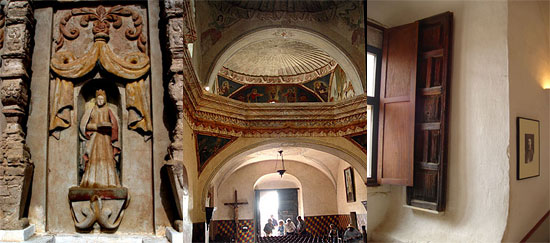
View Comments
John Treadwell Dunbar is a freelance writer